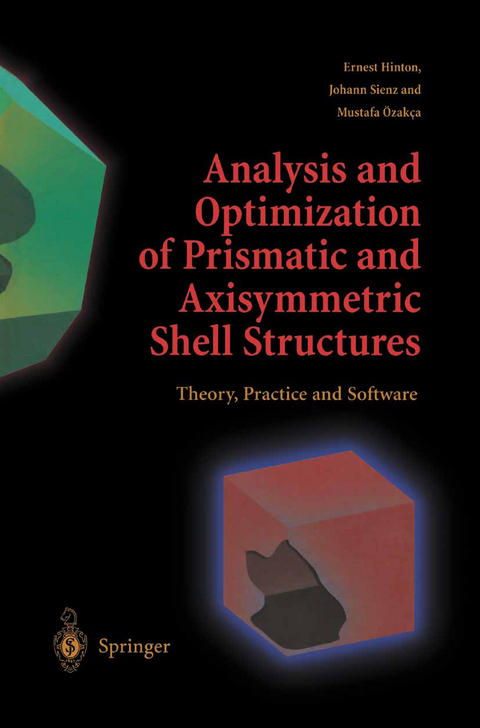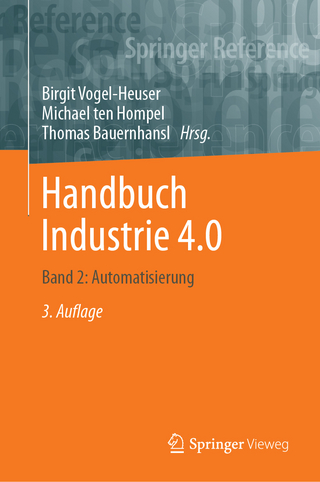
Analysis and Optimization of Prismatic and Axisymmetric Shell Structures
Springer London Ltd (Verlag)
978-1-4471-1059-0 (ISBN)
I: Introduction.- 1 Introduction.- 2 Structural Shape Definition and Automatic Mesh Generation with contributions from NVR Rao.- 3 Structural Optimization Methods and Algorithms.- II: Static Analysis and Optimization.- 4 Basic Finite Element Formulation for Shells of Revolution.- 5 Basic Finite Strip Formulation for Prismatic Shells with contributions from NVR Rao.- 6 Structural Optimization of Shells of Revolution and Prismatic Shells with contributions from NVR Rao.- III: Free Vibration Analysis and Optimization.- 7 Basic Finite Element Formulation for Vibrating Axisymmetric Shells.- 9 Structural Shape Optimization of Vibrating Axisymmetric and Prismatic Shells.- IV: Dynamic and Buckling Analysis and Optimization.- 10 Buckling Analysis and Optimization of Plates and Shells.- 11 Basic Dynamic Analysis of Plates, Solids of Revolution and Finite Prism Type Structures.- Appendices.- A The Evaluation of certain Strain Terms.- B Evaluation of the Radius of Curvature R.- C Musical Scales and Temperament.- Author Index.- V: CD-ROM.- A CD-Rom Overview and Installation Instructions.- A.1 CD-Rom overview.- A.1.1 Software packages.- A.1.2 User manuals.- A.1.3 Tools and other resources.- A.2 Installation instructions of PCs.- A.3 Internet links.- B Documentation and User Instructions of Program “SANOPT-S”.- B.1 Program documentatio.- B.1.1 Overview of the program.- B.1.2 Block structure and main routines.- B.1.3 File structures.- B.1.4 Main dimensions and limitations of the program.- B.2 Input instructions.- B.2.1 Main structure of input data.- B.2.2 User hints.- B.3 Specimen input data files.- B.3.l Cylindrical tank under hydrost atic pressure.- B.3.2 Single-cell right box-girder bridge.- B.3.3 Pinched cylindrical shell with curved planform.- References.- Documentation andUser Instructions of Program “SANOPT-F”.- C.1 Program documentation.- C.1.1 Overview of the program.- C.1.2 Block structure and main routines.- C.1.3 File structures.- C.1.4 Main dimensions and limitations of the program.- C.2 Input instructions.- C.2.1 Main structure of input data.- C.2.2 User hints.- C.3 Specimen input data files.- C.3.1 Conical shell.- C.3.2 Square plate.- C.3.3 Cylindrical shell segment with curved planform.- References.- D Documentation and User Instructions of Program “SANOPT-P”.- D.1 Program documentation.- D.1.1 Overview of the program.- D.1.2 Block structure and main routines.- D.1.3 File structures.- D.1.4 Main dimensions and limitations of the program.- D.2 Input instructions.- D.2.1 Main st ruct ure of input data file for static problems.- D.2.2 Main structure of input dat a file for free-vibration and buckling problems.- D.3 Specimen input data files.- D.3.1 Cylindrical shell roof subjected to self-weight loading.- D.3.2 Thin circular plate.- E Documentation and User Instructions of Program “PREP”.- E.1 Program documentation.- E.1.1 Overview of the program.- E.1.2 Block structure and main routines.- E.1.3 File structures.- E.1.4 Main dimensions and limitations of the program.- E.2 Input instructions.- E.2.1 Main structure of input data.- E.2.2 User hints.- E.3 Specimen input data file.- E.3.1 Cylinder with hemispherical bottom under internal pressure.- F Documentation and User Instructions of Program “SP LINE”.- F.1 Program documentation.- F.1.1 Overview of the program.- F.1.2 Block structure and main routines.- F.1.3 File structures.- F.1.4 Main dimensions and limitations of the program.- F.2 Input instructions.- F.2.1 Main structure of input data.- F.2.2 User hints.- F.3 Specimen input data file.- F.3.1 Wheel geometry.- GDocumentation and User Instructions of Program “OPTIMIZE”.- G.1 Program documentation.- G.1.1 Overview of the program.- G.1.2 Block structure and main routines.- G.1.3 File structures.- G.2 Input instructions.- G.3 Specimen user-supplied subroutines and output data file.- G.3.1 Example.- References.- H Documentation and User Instructions of Program “TRAM”.- H.1 Pro gramdocumentation.- H.1.1 Overview of the program.- H.1.2 Main routines.- H.2 Input instructions.- H.2.1 The glossary of variable names.- H.2.2 Main structure of input data.- H.3 Specimen input data files.- H.3.1 Free-vibration and buckling analysis of square plate.- I Documentation and User Instructions of Program “VISOR”.- I.1 Program documentation.- I.1.1 Overview of the program.- I.1.2 Main routines.- I.2 Input instructions.- I.2.1 The glossary of variable names.- I.2.2 Main structure of input data.- I.3 Specimen input data files.- I.3.1 Simply supported circular plate.- I.3.1 Simply supported square plate.- References.- J Documentation and User Instructions of Program “PLATES”.- J.1 Program documentation.- J.1.1 Overview of the program.- J.1.2 Main routines.- J.2 Input instructions.- J.2.1 The glossary of variable names.- J.2.2 Main structure of input data.- J.3 Specimen input data files.- J.3.1 Homogeneous isotropic rectangular thin plates.
From the reviews:"The book, consisting of 5 parts, starts from introduction and then presents static analysis and optimization. Parts 3 and 4 are devoted to free-vibration analysis and optimization, and to dynamic and buckling analysis and optimization. … The book is accessible to the novice and expert alike, and can be used by students, engineers and scientists working in automotive, aerospace and civil engineering." (Stefan Jendo, Zentralblatt MATH, Vol. 1088 (14), 2006)
| Zusatzinfo | XXXII, 496 p. |
|---|---|
| Verlagsort | England |
| Sprache | englisch |
| Maße | 155 x 235 mm |
| Themenwelt | Informatik ► Weitere Themen ► CAD-Programme |
| Technik ► Bauwesen | |
| Technik ► Fahrzeugbau / Schiffbau | |
| Technik ► Maschinenbau | |
| Schlagworte | axisymmetric shells • finite element analysis • finite strip analysis • Optimization • prismatic shells |
| ISBN-10 | 1-4471-1059-5 / 1447110595 |
| ISBN-13 | 978-1-4471-1059-0 / 9781447110590 |
| Zustand | Neuware |
| Informationen gemäß Produktsicherheitsverordnung (GPSR) | |
| Haben Sie eine Frage zum Produkt? |
aus dem Bereich


